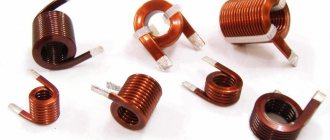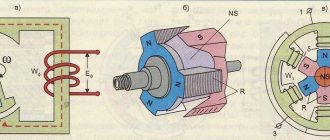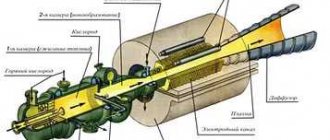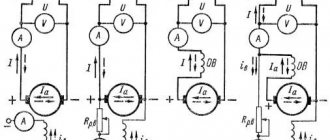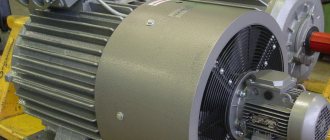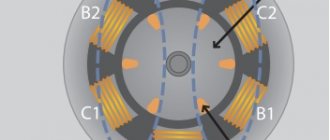Alternating current is the basis of electrical power supply to consumers. It is this current that is delivered to the consumer through an extensive system of overhead and cable lines, in between which it is reduced by transformers.
Alternating current is generated by the operation of powerful generators at power plants. The article will cover in detail the topic of what an alternating current generator is, describe the types of these devices, on what principle its operation and scope of application are based.
Start
The simplest and very first alternating current generator was developed by physicist Michael Faraday in 1831 and was called the Faraday Disk. The design of the first alternating current generator was very simple. It included the following elements:
- Two different polar magnets “N” and “S”.
- Copper wire frame with sides A, B, C, D.
- Rotation axes N and N1.
The principle of operation of the Faraday alternating current generator was that when the frame rotated, a current with a weak voltage was generated. This happens as follows:
- The wire frame rotates inside a constant magnetic field along the N and N 1 axis.
- When the position of the frame changes from vertical to horizontal, the effect of cutting the magnetic field occurs.
- At such moments, an electromotive force (EMF) arises.
- When passing one half-turn, the emf has a positive potential. Current flows from point A to point B.
- When returning to a vertical position, the EMF changes direction from point C to point D, which means the current potential also changes.
All alternators use a rotating magnetic field. When the position of the copper frame changes, there is also a moment of complete loss of voltage. It occurs when rotating slowly, for example, without a motor. During rapid rotation, the voltage remains unchanged.
Famous Generators
Dalai Lama XIV – Generator
Jim Carrey - Generator
Renata Litvinova – Generator
John Lennon - Generator
Madonna - Generator
Famous Generators: Dalai Lama, Carl Jung, Madonna, Mozart, Gogol, Renata Litvinova, Jim Carrey, John Lennon, Bruce Willis, Madonna, Julia Roberts, Eddie Murphy, Albert Einstein, Beethoven.
Purpose and device
Modern alternators work on the same principle, but use different mechanisms as the driving force. The main purpose of an alternator is to convert some type of energy into electrical current. The energy source can be:
- Powerful flow of water. Such devices are used in hydroelectric power plants. The generator is driven by the flow of water through a narrow channel and the rotation of a turbine. The rotating turbine blades spin the generator shaft, thereby converting mechanical energy into electricity.
- Gas burning. Typical for thermal power plants.
- Using the power of the wind. Such generators are installed in the most windy areas. The main disadvantage is the complete shutdown in calm weather.
- Use of nuclear energy.
- The use of diesel or gasoline engines to rotate stationary or automobile generators.
An alternator or alternator consists of the following parts:
- Stator. It is a stationary part of the device. Made from steel sheets that provide resistance to loads. The stator has long slots cut into it to contain the wire winding. This winding removes the generated current.
- Rotor. It is a moving part. Installed directly in the center of the stator. For precise alignment, it is mounted on bearings that are mounted in the front and back covers of the housing. The rotor itself is an electromagnet. It also has grooves and a winding laid in them. It is necessary to excite the stator and generate an electromagnetic field.
- Anchor. A rotor with a winding is mounted on it. It is needed to transmit torque from an engine or turbine.
- Collector. The collector consists of several insulated plates, which are represented by 2 main half rings. Each is connected to the rotor winding. One half with the “+” pole, the other with the minus pole. The generator commutator is needed to rectify and redirect the alternating current.
- Carbon brushes. On some models they are replaced with contact plates. Through the carbon brushes, direct current is supplied from the battery, which is used to pre-excite the rotor winding.
These are the most basic parts that make up the simplest alternator. We examined the design and principle of operation of a modern alternating current generator.
Generators of this type can be synchronous or asynchronous. Both devices are almost identical. The difference between them is as follows. Synchronous and asynchronous models differ in the presence of a winding on the rotor (synchronous) or its absence (asynchronous). The differences also lie in the excitation principle and connection diagram.
Human Design Generator transcript
You can decipher your BodyGraph in detail as a Generator online for free by receiving a demo card. After filling in the date, place and time of birth, you will see the Bodygraph diagram, strategy, profile, false self, authority, definition. I recommend finding out a more accurate time of birth. If you write an approximate number, it will not affect the accuracy of the information you learn from the demo card. A time difference of +/- 7 minutes, as a rule, will only affect in-depth data, such as motivation, environment, etc.
Human Design is a science based on genetics, biochemistry, astrology and ancient beliefs. Taken together, they make it possible to describe in detail the structure of human life, down to nutrition and purpose. In order to better understand himself and his nature, the Generator needs to decipher his Rave card in detail with a detailed explanation of the genetic code, interpretation of directions in life that will help achieve satisfaction.
The bodygraph includes 9 centers, 36 channels and 64 hexagrams. The latter are activated using lines with colors and tones. People can be similar in type, have the same centers and channels. But at deep levels, each Generator is individual. Thus, there can be thousands of possible combinations of Human Design.
Therefore, for a detailed explanation of every detail of your genetic code and deep knowledge of the energetic and inner world, you need a detailed decoding from a specialist. There are two ways to do it: a live consultation with an expert or an electronic consultation that will be sent to you by email. Each of them has its own advantages. Live communication is a great option for those advanced in Human Design. For beginner Generators, the electronic version will be convenient, where everything is explained in clear and easy-to-understand language.
Live consultation (pros and cons)
This type involves communicating with a specialist in person or via video call on Skype. It lasts one to two hours, where they tell you in detail about all aspects, answer your questions, and give advice. Benefits of live consultation:
- Feedback. You can ask questions, find out on the spot unclear aspects in deciphering the Bodygraph Generator;
- Special techniques for map reading and comparison of probabilities;
- Live communication in pleasant company.
Disadvantages of personal consultation:
- It is impossible to tell everything in one or two hours. The specialist reduces the information to convey the main point. You will either have to find out the rest yourself or come to an additional meeting;
- The cost is more than electronic. This is because the specialist is looking for time, spending it both on consultation with you and on preliminary preparation.
Electronic transcript (pros)
Electronic decoding of the Rave card occurs as follows. You choose its type. The decryption can be basic, which includes the 1st part and an extension - the 2nd part. There is also a complete one - it combines the entire package and is more convenient for studying. In addition, when ordering the full version, you will receive preferential consultation and additional materials. All transcripts are compiled from our internal database, which is based on professional sources. After payment, you will receive a ready-made BodyGraph Generator document with an accessible presentation, supplemented with examples and tips.
Electronic interpretation of the Bodygraph has several advantages:
- Clear and structured presentation, explanation of your Bodygraph in blocks;
- The ability to read and study your nature on any electronic device and in any place convenient for you;
- Unlimited volume of material that would not fit into one live consultation;
- Lower cost compared to live communication, without losing its quality.
- Ease of presentation of information that will be understandable to both beginners and experienced professionals.
You can order a detailed transcript of the Rave card on this page. The service provides deep detail of the Bodygraph, which not every Analyst is able to provide during a consultation.
At an affordable price, you will receive the most complete instructions for your life with the author's recommendations. Thus, there is an opportunity to save time, because it will not be spent both on independent decoding and on making mistakes in life. This is your chance to experiment and, as a true Generator, get your rightful satisfaction.
Varieties
The internal structure of an alternator depends on its type. Electric machines are divided into 2 main types:
- Synchronous.
- Asynchronous.
There is also a classification according to:
- Method of arousal.
- Number of phases.
- By type of rotor and stator.
Next, a detailed description of all classifications will be given.
Synchronous
The synchronous type alternator has a main feature by which it can be identified at first glance. There is a winding wire on its rotor. It is necessary to stabilize the frequency between the stator and rotor. The EMF in such a device is created due to the intersection of the magnetic pole of the rotor and the stator winding.
A synchronous type alternator is equipped with rotors with several poles, the number of which is always a multiple of 2, for example, 2, 4, 6, 8. The alternator operates according to the following principle:
- After starting, the rotor creates a very weak magnetic field. The magnitude of the EMF increases as the shaft speed increases. For initial excitation, constant voltage from the battery or control unit is used.
- If the generator is powered by an internal combustion engine, the speed must first be stabilized to obtain a stable alternating voltage.
- After setting the required speed, the voltage is stabilized by the automatic regulation unit (AVR). Engine speed greatly affects the frequency of the alternating voltage at the output and its power. The optimal rotation speed is up to 3000 rpm. AVR stabilizes the voltage to this parameter, and in the event of a failure, significantly reduces the voltage. Otherwise, electric pumps can quickly lose power and overheat.
The operation of such a generator is highly dependent on the type of load. The induction type load greatly affects the demagnetization of the armature. This effect results in a large voltage loss.
With capacitive loads, the armature, on the contrary, is magnetized, which significantly increases the output voltage. The circuit of a synchronous type alternating current generator is shown below.
The synchronous alternator has one big advantage. Its output voltage is much higher (3-4 times) the nominal values. An increase is necessary if the device powers electric pumps, appliances and devices that require starting current. Such devices greatly increase the reactive loads on the general network, which a synchronous generator can cope with.
This generator also has disadvantages. The first is the high sensitivity to overload in the circuit. The reaction to the load is a short but quite powerful current on the rotor winding, which appears due to an increase in the current by the control unit itself. As a result, the winding burns out or heats up.
The second disadvantage is sparking. The simplest synchronous type generator has slip rings with brushes installed on the rotor. They are unsafe for use in industrial plants where flammable gases or liquids are present. For such cases, three machine synchronous generators are used. The design and operating principle of this type of alternator is very different. This generator consists of:
- Pre pathogen.
- Pathogen.
- The generator itself.
All these elements are installed on a common shaft. The work is carried out as follows:
- Permanent magnets installed on the shaft excite the winding of the synchronous generator before the exciter. Such a generator does not require a battery or an additional generator for excitation. Its work is based on the phenomenon of magnetic induction, which occurs when a permanent magnet rotates.
- The voltage that it generated is redirected to the exciter, or rather to its stator winding.
- The rotor winding is connected to a three-phase voltage rectifier.
- They are excited by the exciter stator.
Ultimately, the generator produces the nominal required voltage, which is regulated by the AVR unit. All operation of such a device is carried out in one housing, which is completely sealed.
Asynchronous
An asynchronous alternating current generator has a different device. Its rotor has no winding. For this reason, the principle of its operation is very different. During rotation, the rotor of such a generator advances the rotation of the magnetic fields that are created by the stator. The rotors of these devices have 2 types of winding: short-circuited and phase. The operating principle of asynchronous electric generators is as follows:
- A magnetic field is created on the auxiliary winding by the stator.
- After which the field is transmitted to the rotor and forms an EMF on the stator winding.
- The generated voltage is supplied to the control unit.
The main difference is the impossibility of adjusting the voltage at a set speed. Asynchronous generators are highly dependent on drive motors. Any loss of stability leads to a decrease in voltage and frequency of the current.
The advantage of such devices is their low sensitivity to short circuits. Application - power supply of household appliances, welding equipment and electric pumps. When there is a reactive load, the AVR must increase the speed of the drive motor for a short period of time. At the same time, a step-down transformer included in the circuit protects other devices from overvoltage.
How to assemble
To make an asynchronous generator, proceed as follows:
- The engine is placed on a supporting structure together with transmission drives.
- Next, variable capacitors are connected to the windings; the windings are connected according to a star circuit, some of the ends of these windings go in the center, where they touch each other, and the others are output separately. ;
- After this, the capacitors are connected in the shape of a triangle and the ends of the windings are connected to the top of this figure.
The power indicator of the resulting machine ranges from two to five kilowatts.
Before running the generator at full power, it is necessary to check that it is functioning correctly. To do this, you need to take a standard incandescent lamp with a power rating of tens of watts. You need to make sure that the generator produces voltage without interruption.
Phases
The most common and universal types of alternating current generators have 3 independent windings. Such devices are three-phase. Their operating principle is as follows:
- There are 3 windings around the circumference of the power part of the generator stator. They have an offset of 120 degrees.
- Rotation of the rotor excites an EMF of alternating potential in these windings.
- The EMFs have a clock shift of 1 third.
Each winding of such a device is an independent single-phase alternating current generator that is capable of powering a household network.
To reduce the number of conductors that are connected to the generator, one common wire is used. It replaces 3 conductors from receivers. This conductor becomes the neutral. The main features of three-phase generators are as follows:
- The device generates linear and phase voltages.
- With the same load on each phase, no electrical energy flows through the neutral wire.
- When the loads differ, the neutral becomes a current conductor.
- If the generator produces high voltage (more than 380 volts), a step-down transformer is easily connected to its output to transmit electric current to household and industrial networks.
The general diagram of a three-phase generator is presented below.
Three-phase generators can be used for domestic needs. But the connection should be made between several consumers or premises. For individual consumption, a single-phase synchronous type model is suitable. The main thing is to choose a model of suitable power with a small margin.
Sacral Center of the Generator
The Sacral Center in Human Design is associated with everyone's reproductive system and is responsible for sexuality, vitality and performance. If it is open (you can observe this by constructing your map) - the person experiences a constant lack of work, sex, food, etc. Most of humanity has a closed Sacral center. This means that they have a constant and sustainable source of vitality.
Generators have a specific or closed sacral center. They have a constant flow of energy inside them that needs to be released somewhere. It is very important for generators to find an activity for their inexhaustible energy that they enjoy. This is the key to their happiness.
Excitation
According to the method of excitation, generators are divided into 4 main types. They are as follows:
- Excitement from an outside source. Often this source is a battery or DC generator.
- Self-excited devices. Voltage is supplied to the winding through a rectifier. These types of DC generators are started from a battery, which is connected in parallel to the starter of the internal combustion engine. Also, power can be supplied from the control unit, which is connected to the battery, but significantly increases the current for starting excitation.
- Parallel generator. Or a device consisting of two generators of different power, which are mounted on the same shaft. A low-power device starts from a battery, and the generated voltage is redirected to a more powerful alternator. Both devices are powered by the same drive motor.
- No excitement. Alternating current is produced by an alternator by rotating a permanent magnet. It is enough to simply start the traction motor and the excitation appears due to the magnet. Such devices are the most effective. Does not depend on the presence of a battery. Can be used as mobile stations. For example, three-machine alternators use this operating principle.
Alternating current generators may have a similar design. Often industrial and household models differ only in size and layout. But there is a difference in the principle of excitation and the number of phases. There is also a classification according to the connection diagram of the internal winding.
Important points
The voltage (U) and capacity of the car battery are the main parameters that need to be paid attention to when choosing and checking a power source.
The main purpose of the battery is to start the engine during the period when the car's generator has not yet been connected to work, and the battery is the only power source.
To eliminate operational problems, the car owner should know the following points:
- What does the battery life depend on?
- What should the voltage be (in normal mode, after starting the engine and under load);
- What causes the decrease in capacity during the cold season and other issues.
Let's consider these questions in detail.
Connection diagrams
There are two main schemes for connecting the internal winding. Each with its own characteristics.
- Star. This connection involves connecting 3 winding outputs to a single point. This point is called "zero". The conductors connected to each beginning of the winding are linear and supply current directly to the consumer. The fourth conductor is considered zero. This connection greatly increases the resistance of the network to phase shifts during the occurrence of unbalanced load differences.
- Triangle. The triangle pattern is different from the star pattern. It assumes serial contact of all windings. The first winding is connected at its end to the beginning of the second, and the end of the second to the beginning of the third. The end of the third and the beginning of the first winding are connected to each other. Linear conductors are drawn from each connection point. This scheme implies a balance between phase and line voltages. This circuit is very sensitive to load differences on each phase. When a difference appears, it is necessary to compile a vector diagram and recalculate all parameters.
Each connection diagram also assumes the same wire cross-section. If a large load occurs on one phase, its wire may burn out, which will lead to an asymmetry in the circuit, and in this case, current will flow through the neutral.
Book "Awakening of the Generator"
Awareness of your nature and revelation of your unique frequency
This book is based on professional materials on the topic of Human Design, as well as my personal experience and observations. This publication sets out in detail the mechanisms of the Generator nature (Manifesting too), its functions, problems and methods of restoring the natural frequency of vibrations. 2 books in one.
After reading this book you will learn the following:
- Basics of Generator essence with examples
- Generator slave/Generator builder
- Conditioning/Deconditioning
- External Authority and Illusions
- Inner Authority
- False Self and its voices
- Basics of the Sacral Center
- How to charge and discharge
- What is response
- Strategies for correct decisions
- Generator Errors
- Generator's main fear
- What does it mean to surrender to the response?
- Response and Emotional Center
- What is a real Generator mutation?
- What kind of people does the Generator need to gather around itself?
- The Benefits of Frustration
And much more 56 Pages PDF.
Buy a book
Inverter
The inverter alternator generator is a modern and versatile unit that can be used for domestic and industrial needs. The device consists of the following parts:
- ICE running on gasoline or diesel fuel.
- A simple generator that produces alternating current.
- Inverter converter.
- Special connectors for connecting the load.
- Control part.
The peculiarity of such devices is a stable voltage output, the ability to connect to alternating and direct current through separate sockets. Let's look at how this type of generator works.
- The internal combustion engine drives the shaft of a synchronous generator.
- The generated alternating voltage is supplied to a rectifier, which includes a transformer, a diode bridge and a radiator for cooling.
- After the rectifier, which is a converter unit, the current acquires a pulsating voltage with a frequency of up to 20,000 Hz.
- The pulsating current is directed to the filter and passed through the capacitor. As a result, the current levels out and becomes constant with a voltage of 12–20 volts (depending on the type of device).
- The direct current is transmitted to an inverter, which converts it into alternating current with an operating frequency of 50 Hz.
The output of the connector produces a current with a frequency of 50 Hz and a voltage of 220 volts. Inverter generator models have a significant advantage. It consists in the following design nuances:
- AC output with ideal sine wave. This ensures uninterrupted operation of sensitive equipment.
- The filter of the device is assembled on high-voltage capacitors capable of transmitting voltage up to 400 volts.
- A sine wave is formed by a transistor switch. The key repeatedly converts the sine wave due to the paired operation of transistors.
- The device can operate in overload mode for only a few seconds. When the load increases, the protection is triggered and turns off the generator without stopping the internal combustion engine.
At the moment, there are 3 main types of inverter generators:
- Rectangular. Used to power 1–3 low-power electrical appliances.
- Trapezoidal. More powerful. Application - they can power household appliances, but the circuit should not contain devices with high resistance (kettles, stoves, ovens).
- Sinusoidal. The most powerful devices with stable voltage. Can be used to power complex and sensitive equipment and household appliances.
Inverter alternators are compact and quite easy to install and use. They can be connected to a household network through a regular switch, with the main network previously disconnected.
Human Design Generator Profile
A profile in Human Design is the lines that outline the character and personality of a type. You can find out by making a free demo card on the website, but detailed information can be obtained by ordering a detailed personal transcript of the Rave card. From it you will learn what you should not waste your energy on, and where you can direct your energy to achieve the Generator signature - satisfaction.
- generator profile 1/3 A Martyr Researcher is a person who discovers everything around him by learning from his mistakes, with the help of his own experience. This personality is deep within itself. Its main goal is to provide a solid foundation in life.
- generator profile 1/4 An Opportunist Researcher is a person who is constantly developing and learning new things. Continuous improvement and the opportunity to share this information with friends and loved ones are important to him.
- generator profile 2/4 The Hermit-Opportunist is a person who often does what he loves alone. They have a secret mission and take great care of their own privacy.
- generator profile 2/5 Hermit-Heretic - loves to be alone, to live by the rules he sets himself. It is important for him to live purposefully and motivated. Reputation in society is also important.
- generator profile 3/5 Martyr-Heretic is a constant tester, a risk-taker, an experimenter who is not stopped by failures. He always strives to discover something new.
- generator profile 3/6 Martyr-Role Model - experience everything themselves, are not afraid of problems and difficult tests. By example, fearlessness can influence and motivate people.
- generator profile 4/1 Opportunist-Researcher - a person who has his own goal and unchanging personality. He is firmly grounded in life through learning and aspiration from childhood. These are good teachers.
- generator profile 4/6 - Opportunist-Role Model is an observer. He is a good friend who strives to influence everyone around him.
- generator profile 5/1 Heretic Researcher - human assistant. He always looks at circumstances from the other side he has studied.
- generator profile 5/2 The Heretic Hermit is a closed person who is constantly waiting to be called in order to express himself in communication with other people.
- generator profile 6/2 Role Model Hermit is a person with many challenges in the first half of his life. In the second, they watch others make mistakes, and in the third, they achieve insight and become an example of a way of life for others.
- generator profile 6/3 Role Model Martyr - an optimist, a positive person who even looks at difficulties with a smile. Recognizes and accepts himself and becomes his own example.
Principle of operation
An electric generator is a device for generating electricity. It can be used to power electrical devices.
- An electric generator can power devices in a private home during a power outage.
- However, it can also be successfully used where it will be an independent source of electricity.
- Such places would be, for example, a garage, workshop, garden or construction site.
Differences
Next, you will need to understand the main differences between alternating and direct current generators. They are as follows:
- The DC generator is equipped with a semi-ring to change the direction of the current.
- A diode bridge can be used to obtain a constant voltage.
- The need to use a regulator relay.
- There is also a difference depending on the speed of the drive mechanism.
For example, a car alternator cannot charge the battery when idling. In this mode, the machine engine rotates at a frequency of 800 rpm. Such revolutions are not enough to generate a charging current of sufficient power.
- The DC generator is equipped with a semi-ring to change the direction of the current.
- A diode bridge can be used to obtain a constant voltage.
- The need to use a regulator relay.
- There is also a difference depending on the speed of the drive mechanism. For example, a car generator cannot charge the battery when idling. In this mode, the machine engine rotates at a frequency of 800 rpm. Such revolutions are not enough to generate a charging current of sufficient power.
- The use of a delta connection is not used in DC generators. The reason lies in the fact that there is an abrupt change in phase EMF over time. In AC electric machines, such changes are smoother.
- Devices that generate electricity do not have much design difference. But constant-type generators require more human control. AC electric machines are more reliable and require less intervention, since they are often not equipped with complex electronic equipment for voltage regulation and control.
- Alternating voltage is generated at lower costs for copper windings, while the overall dimensions of such generators can be significantly smaller.
- To generate charging current, the generator must operate through a transmission mechanism. This is the only way to achieve instantaneous production of the desired value at low speeds.
The use of electrical machines that produce direct current is not advisable. This is due to the fact that they are less reliable. Much less expensive are devices for generating alternating voltage, which are equipped with rectifiers. Such a mechanism can operate at almost any speed while maintaining the required voltage and has overload protection. The dimensions of such a device will be much smaller, while the output power of the devices will be the same.
